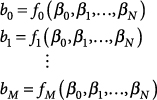Note 46. Inverse z Transform via Partial Fraction Expansion:
Case 1: All Poles Distinct with M < N in System Function
This note covers the form of the partial fraction expansion that can be used to compute the inverse z transform of system functions that have no repeated poles and in which the degree of the denominator polynomial exceeds the degree of the numerator polynomial. The method is based on the basic strategy discussed in Note 45. Alternative approaches for use on system functions that do not meet these constraints are covered in Notes 47 through 49.
The form of the partial fraction expansion discussed in this note is suitable for use on system functions of the form
46.1

where M < N, thus making H(z) a proper rational function.
The expansion can be formed directly by using each binomial factor from the denominator of Eq. (46.1) as a denominator for one of the fractional terms in the expansion:
46.2
![]()
When a common denominator is generated to perform the additions indicated in Eq. (46.2), the resulting denominator always equals the denominator in Eq. (46.1). Therefore, we can simplify the notation by just retaining the numerator that results after the common denominator has been implemented to accomplish the additions. This “numerators-only” equation has the form
46.3

Typically, the values for all the poles, pk, are known, so straightforward algebraic manipulations can be used to put the right-hand side of Eq. (46.3) into a form in which the coefficient for each power of z–1 is obtained as a function of the unknown coefficients, βnk:
46.4

Coefficients for like powers of z must have the same value in the LHS of Eq. (46.3) and in the RHS of Eq. (46.4) so we can construct the system of equations
46.5

From the form of the RHS of Eq. (46.3), we know that each function, fm(β0, β1, . . ., βN), is a linear function of the coefficients, βn, so it is a straightforward process to solve this system of equations for the unknown values of βn.
Once the values for the βn are found, the filter’s unit sample response can be written as
46.6
![]()
This approach for computing the inverse z transform is summarized in Design Procedure 46.1, and is demonstrated in Example 46.1.







